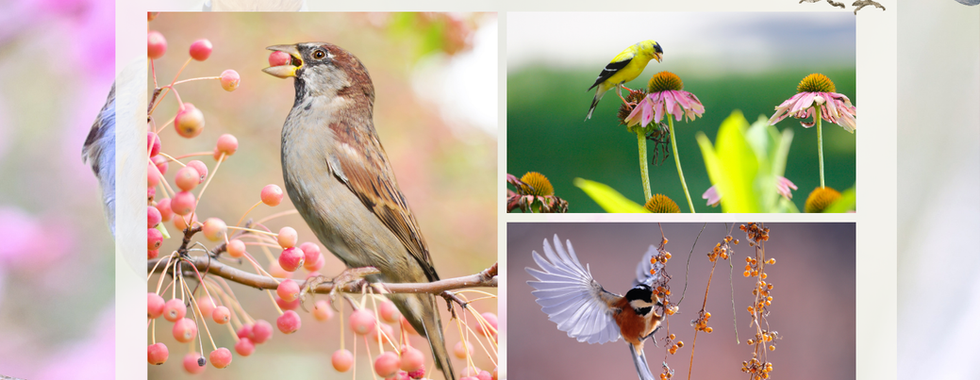Hello! Angely here! 🐤This Tuesday we're discussing how to build a backyard buffet for native birds and each native Ohio plant lists what specific birds they attract!
Native Plants Featured:
Black Eyed Susan (𝘙𝘶𝘥𝘣𝘦𝘤𝘬𝘪𝘢 𝘩𝘪𝘳𝘵𝘢)
Cup Plant (𝘚𝘪𝘭𝘱𝘩𝘪𝘶𝘮 𝘱𝘦𝘳𝘧𝘰𝘭𝘪𝘢𝘵𝘶𝘮)
American Plum (𝘗𝘳𝘶𝘯𝘶𝘴 𝘢𝘮𝘦𝘳𝘪𝘤𝘢𝘯𝘢)
Wild Strawberry (𝘍𝘳𝘢𝘨𝘢𝘳𝘪𝘢 𝘷𝘪𝘳𝘨𝘪𝘯𝘪𝘢𝘯𝘢)
Prairie Blazing Star (𝘓𝘪𝘢𝘵𝘳𝘪𝘴 𝘱𝘺𝘤𝘯𝘰𝘴𝘵𝘢𝘤𝘩𝘺𝘢)
Smooth Sumac (𝘙𝘩𝘶𝘴 𝘨𝘭𝘢𝘣𝘳𝘢)
Wild Bergamot (𝘔𝘰𝘯𝘢𝘳𝘥𝘢 𝘧𝘪𝘴𝘵𝘶𝘭𝘰𝘴𝘢)
Red Mulberry Tree (𝘔𝘰𝘳𝘶𝘴 𝘳𝘶𝘣𝘳𝘢)
Smooth Blue Aster (𝘚𝘺𝘮𝘱𝘩𝘺𝘰𝘵𝘳𝘪𝘤𝘩𝘶𝘮 𝘭𝘢𝘦𝘷𝘦)
And Don't Forget Other Needed Elements to Support Your Wildlife
Provide Water Sources
Wildlife needs water for drinking and bathing. You can include:
Birdbaths: Keep them clean and filled.
Small Ponds: Add a variety of aquatic plants and maybe a small pump for circulating water.
Water Features: Bubbling fountains or drip systems.
Create Shelter
Shelter is crucial for wildlife. Options include:
Brush Piles: Pile up sticks and branches to provide cover for small animals.
Rock Piles: Great for reptiles and amphibians.
Nest Boxes: For birds like bluebirds, chickadees, and owls.
Native Shrubs and Ground Cover: Dense plantings offer shelter and nesting sites.
Minimize Broad Spectrum Chemicals and Follow All Application Directions
Avoid using pesticides and herbicides that can harm unintended targets in your backyard wildlife. Use natural pest control methods like companion planting and introducing beneficial insects. And when using ANY chemicals, follow all instructions to minimize issues of concern, e.g. drift, damage, water & soil contamination, resistance, etc.
Leave Some Areas Natural
Let parts of your yard grow wild to provide a natural habitat. Avoid manicuring every part of your lawn, allowing for more biodiversity.
Create a Diversity of Habitats
Incorporate different elements to attract a variety of wildlife:
Meadow Areas: Plant a mix of wildflowers and grasses.
Woodland Edges: Blend trees and shrubs to create transition zones.
Wetlands: Even small, damp areas can attract frogs and insects.
Maintain a Healthy Ecosystem
Encourage a balanced ecosystem by:
Composting: Recycle organic matter to enrich the soil.
Plant Layering: Mimic natural forests with layers of vegetation.
Promote Pollinators: Create habitats specifically for bees, butterflies, and other pollinators.
Seasonal Considerations
Ensure there is something available year-round:
Spring: Early blooming flowers and fresh foliage.
Summer: Abundant flowers and fruits.
Fall: Late-season blooms and seed heads.
Winter: Evergreens, berries, and shelter.
Educational and Community Involvement
Engage with your local community:
Wildlife Workshops: Learn more about native species and their needs.
Wildlife Garden Tours: Visit other local wildlife-friendly gardens.
Volunteering: Participate in local conservation projects.






















Commentaires